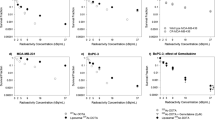Summary
The chemotherapeutic activity of five cytostatic drugs was investigated experimentally in monotherapy and in two-drug combinations, using Yoshida sarcoma cells implanted into the wall of the glandular stomach of Sprague-Dawley rats. In monotherapy, the antibiotic agent mitomycin C and the nitrosourea methyl-CCNU exhibited the highest cytotoxic activity in this tumor model. In combination therapy, the combination of these two drugs was superior to all the other therapeutic schemes tested. In general, the results demonstrate a marked superiority of combination therapy in comparison with monotherapy.
Similar content being viewed by others
References
Ansfield FJ, Schroeder JM, Curreri AR (1962) Five years clinical experience with 5-fluorouracil. JAMA 181:295–299
Bhide S, Habs M, Reinbold H Schmähl D (1979) Studies on the effect of cyclophosphamide on Yoshida sarcoma ascites cells implanted into the colon wall of rats. Arzneim Forsch 29:477–479
Carter SK, Comis RL (1977) Gastric cancer: current status of treatment. J Natl Cancer Inst 58:567–568
Comis RL, Carter SK (1974) A review of chemotherapy in gastric cancer. Cancer 34:1576–1586
Douglass HD, Lavin PT, Moertel CG (1976) Nitrosoureas: useful agents for the treatment of advanced gastrointestinal cancer. Cancer Treat Rep 60:769–780
Friedman MA, Kimura K, Sakurai Y, Ogawa M, Carter, SK (1980) (for the Northern California Oncology Group) Chemotherapy of advanced gastric cancer. Proc. ASCO 21:418
Habs M (1981) Methoden, Ergebnisse und Probleme der experimentellen Chemotherapie. In: Schmähl D (Hrsg) Maligne Tumoran-Entstehung, Wachstum, Chemotherapie. Editio Cantor, Aulendorf, S 455–498
Habs M, Reinbold H, Eisenbrand G, Bhide S, Goga-Ionesco S, Schmähl D (1981) Antitumor activity of new nitrosoureas on Yoshida sarcoma ascites cells implanted into the colon wall of rats. J Cancer Res Clin Oncol 101:285–302
Kisner DL, MacDonald JS (1982) Chemotherapy of metastatic gastrointestinal cancers: prospects for future adjuvant systemic therapies. Res Results Cancer Res 80:291–295
MacDonald JS, Schein P, Ueno W, Woolley PV (1979) 5-Fluorouracil, mitomycin C and adriamycin (FAM): A new combination chemotherapy program for advanced gastric carcinoma. Cancer 44:42–47
Mantel N (1958) An experimental design in combination chemotherapy. Ann NY Acad Sci 76:909–914
Moertel CG, Mittelman JA, Bakemeier RF, Engstrom P, Hanley J (1976) Sequential and combination chemotherapy of advanced gastric cancer. Cancer 38:678–682
Moertel CG, O'Connell MJ, Lavin PT (1979) Chemotherapy of gastric carcinoma. Proc AACR 20:288
O'Connell M, O'Fallon J, Lavin P, Moertel C, Bruckner H, Douglass H Jr, Livestone E, Lokich J, Mitchell M (1980) A comparative assessment of combination chemotherapy in advanced gastric carcinoma. Proc ASCO 21:420
Panettiere F, Heibrun L (1979) Comparison of two different combinations of adriamycin, mitomycin-C and 5-FU in the management of gastric carcinoma: A SWOG study. Proc AACR 20:315
Peto R (1974) Guidelines on the analysis of tumor rates and death rates in experimental animals. Br J Cancer 29:101–105
Peto R, Pike, MC, Day NE, Gray RG, Lee PN, Parish S, Peto J, Richards S, Wahrendorf J (1980) Guidelines for simple, sensitive significance tests for carcinogenic effects in long-term animal experiments. In: AIRC monographs on the evaluation of the carcinogenic risk of chemicals to humans. Suppl 2: Long-term and short-term screening assays for carcinogens, a critical appraisal. IARC, Lyon, pp 311–426
Schmähl D, Mecke R (1955) Quantitative Transplantationsversuche mit dem Yoshida-Ascitessarkom der Ratte. Z Krebsforsch 60:711–729
Schmähl D, Osswald H, Prochotta L (1967) Quantitative Untersuchungen an Ratten über die Resistenz verschiedener Organe gegen inoculierte Tumorzellen. Z Krebsforsch 70:130–137
Yoshida T (1949) The Yoshida sarcoma, an ascites tumor. Gann 40:1–18
Yoshida T (1952) Studies on an ascites (reticuloendothelial cell?) sarcoma of the rat. J Natl Cancer Inst 12:947–962
Author information
Authors and Affiliations
Additional information
These studies correspond to the doctoral thesis “Chemotherapeutische Studien an Ratten mit in den Drüsenmagen implantierten Yoshida-Sarkom-Asciteszellen: Monotherapie mit 5-Fluorouracil, Methyl-CCNU, Mitomycin C, Adriamycin und Cytosinarabinosid, Kombinationstherapie mit den Zweierkombinationen dieser Substanzen” submitted to the Medical Faculty of Heidelberg University in 1982 by G. Eichler
Rights and permissions
About this article
Cite this article
Eichler, G., Habs, M. & Schmähl, D. Chemotherapeutic study on Yoshida sarcoma ascites cells implanted into the glandular stomach of rats. J Cancer Res Clin Oncol 105, 250–257 (1983). https://doi.org/10.1007/BF00395753
Received:
Accepted:
Issue Date:
DOI: https://doi.org/10.1007/BF00395753




